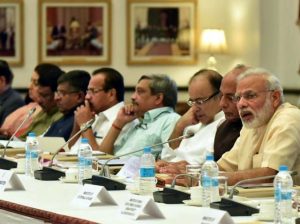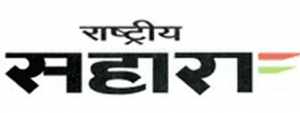
27-06-2017 (Important News Clippings)
To Download Click Here.
Badminton Badshah
Srikanth’s sterling performance wins him back to back Super Series titles
TOI Editorials

Indian badminton is witnessing a renaissance as its shuttlers are consistently beating the world’s best. Srikanth had got the better of current world number one player Son Wan Ho a week earlier in Jakarta as well. Ho and Long are the most feared players on the circuit. Moreover, the 24-year-old is not alone when it comes to spectacular performances. His teammate HS Prannoy too scalped Long and three-time Olympic champion Lee Chong Wei in consecutive days earlier this month. India now boasts of six shuttlers among the top 50 in the world.
Both Srikanth and Prannoy have come up from the stables of former All England champion Pullela Gopichand’s academy in Hyderabad. This is ample proof that given the right coaching, environment and exposure, India is capable of producing world class players. It also strengthens the case for letting former players run the affairs of various sporting federations. Structural deficiencies plague the current administration where international sporting events are still considered opportunities for foreign junkets by our officials. Former players may not be able to win elections of sporting federations but they may understand the game better and be able to focus on key areas where players needs help.
सचिवों के लिए निर्धारित कार्यकाल की अवधि में विस्तार की दरकार
ए के भट्टाचार्य

Inclusive spaces
Government needs to finetune the definition and objective of the smart city project.
Editorials
The Union Ministry of Urban Development’s list of smart cities is almost complete. Last week, the ministry released its fourth list under the Smart City Mission, taking the total number of cities picked under the Centre’s flagship project to 90 — 10 more cities will be included in the project. The ministry claims that the selected cities will develop systems that will enable them to become world class cities. A report in this paper, however, points to an important concern relating to the project: A lion’s share of the Centre’s investment in the Smart City Mission will flow to well-developed pockets that account for less than 3 per cent of the cumulative area of the cities.
One of the stated objectives of the Smart City Mission was to act as a corrective to a lopsided developmental pattern. The mission intended to “create employment and enhance incomes for all, especially the poor and disadvantaged leading to inclusive cities”. This emphasis on inclusive development has been diluted. Only 26 of the cities selected last week have plans to provide affordable housing, education and medical facilities.
The city development plans should have been aligned with some of the government’s employment-generating initiatives, such as Make In India. Sensor-based public lighting and road redesign schemes seem to have caught the government’s fancy, instead. The government does have plans to promote start-ups and infrastructure projects. But these projects are concentrated in tiny pockets in the selected cities — nearly 80 per cent of the Centre’s funds are skewed towards them. For example, in Pune, from where Prime Minister Narendra Modi flagged off the Smart City projects last year, around 75 per cent of the investment will be used for the development of a 3.6 sq km area in the Aundh-Baner-Balewadi pocket, which comprises a little more than 1 per cent of the city’s total area.
Smart city plans have also not found a way to deal with recurring problems. For instance, Aizawl, which found a place in the urban development ministry’s latest list, was in the grip of a severe water crisis in the third week of this month. The shortage was caused by damages to water pipelines by floods — a problem which the city has not yet addressed effectively. Guwahati, amongst the earliest to be included in the smart city list, also has no effective plan to deal with floods that ravage it every year.
As it finalises the list of cities, the Centre will do well to further finetune the definition of “smartness” and to re-think its priorities in terms of funding. It needs to remind itself of the original goal of the Smart City Mission — making cities inclusive.
लिस्बन से निकटता
संपादकीय
प्रधानमंत्री नरेन्द्र मोदी की पुर्तगाल यात्रा हर दृष्टि से सफल मानी जाएगी। जो 11 समझौते दोनों देशों के बीच हुए, उसे देखें तो युवा और सांस्कृतिक आदान-प्रदान से लेकर विज्ञान एवं प्रौद्योगिकी में शोध को बढ़ावा देने, बाहरी अंतरिक्ष, दोहरे कराधान से बचाव, नैनो प्रौद्योगिकी, उच्च शिक्षा और वैज्ञानिक अनुसंधान, पुर्तगाल-भारत व्यापार केंद्र की स्थापना आदि अनेक क्षेत्र शामिल हैं। ये दोनों देशों के संबंधों को यकीनन और गहरा करेंगे। दोनों देशों ने विज्ञान एवं प्रौद्योगिकी में शोध को बढ़ावा देने के लिए 40 लाख यूरो के संयुक्त कोष की घोषणा की। आतंकवाद से मुकाबले में आपसी सहयोग पर भी सहमति बनी है। संयुक्त संवाददाता सम्मेलन में मोदी और पुर्तगाल के प्रधानमंत्री एंटोनियो कोस्टा ने कहा कि दोनों देशों के रिश्तों में पिछले छह महीने में काफी प्रगति हुई है। मोदी ने ठीक ही कहा कि पुर्तगाल की अर्थव्यवस्था में फिर से आई तेजी और भारत की ठोस वृद्धि ने हमें साथ बढ़ने का सुनहरा मौका दिया है। कई लोगों का मानना है कि पुर्तगाल की अंतरराष्ट्रीय पटल पर ऐसी हैसियत नहीं है कि उससे संबंधों को महत्त्व दिया जाए। इस तरह की धारणा उचित नहीं है। दुनिया के किसी देश को महत्त्वहीन नहीं माना जा सकता। वैसे भी पुर्तगाल यूरोपीय संघ का सक्रिय सदस्य है। भारत को अपने आर्थिक विकास के साथ भविष्य के रणनीतिक विस्तार के लिए अधिक-से-अधिक देशों का साथ चाहिए। पुर्तगाल एक ऐसा देश है जिसका लगाव अभी भी भारत से है। वर्तमान प्रधानमंत्री एंटोनियो कोस्टा के खनदान के कई लोग अभी भी गोवा में रहते हैं। कोस्टा पहले भारतीय मूल के पुर्तगाली प्रधानमंत्री हैं। इसलिए भारत के प्रति उनका निजी लगाव भी है। वर्तमान यात्रा के दौरान कोस्टा को मोदी ने ओवसीज सिटीजन औफ इंडिया का कार्ड प्रदान किया। पुर्तगाल ने खुलकर भारत को संयुक्त राष्ट्र सुरक्षा परिषद की स्थायी सदस्यता का समर्थन किया है। वह एनएसजी यानी नाभिकीय आपूत्तर्िकर्ता समूह का सदस्य भी है। इस नाते भारत के लिए उसका महत्त्व है। जिस तरह कोस्टा ने मोदी का स्वागत किया, उनके लिए दोपहर के भोजन में विशेष गुजराती व्यंजन की व्यवस्था की, उनके हर कार्यक्रम मंदिर में पूजा से लेकर भारतीय समुदाय को संबोधन और अमेरिका रवानगी तक साथ रहे उससे साफ झलकता है कि पुर्तगाल की नजर में भारत का विशेष महत्त्व है और इसका असर आने वाले दिनों में दिखाई देगा।




